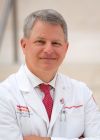The pericardium is a thin sac that surrounds and separates the heart from the lungs and surrounding structures in the chest. There is a visceral pericardium, which is adherent on the surface of the heart, and a parietal pericardium which lines the fibrous sac. Between the two layers is normally a small amount of lubricating pericardial fluid.
The layers of the pericardium can become inflamed for a variety of reasons, leading to pericarditis. This inflammation can cause chest pain and EKG changes. Pericarditis may also lead to fluid accumulation and a large pericardial effusion. Patients with symptomatic pericardial effusions or pericardial tamponade (pressurized fluid compressing on the heart) may require a procedure to drain the fluid. Weill Cornell Medicine|NewYork-Presbyterian physicians are skilled at a variety of methods for draining the pericardium, including percutaneous drainage with a pericardiocentesis or a surgical drainage with a pericardial window.
When the pericardium is chronically inflamed, this may lead to severe thickening of the pericardium. The pericardium becomes stiff and the heart becomes encased in an immobile shell, leading to chronic constrictive pericarditis. The diagnosis of pericardial constriction requires specific criteria from a number of tests, including echocardiography, CT/MRI, and pressure recording with cardiac catheterization. Weill Cornell cardiac surgeons work closely with Cardiology colleagues with arrive at the proper diagnosis.
Constrictive pericarditis treatment involves a pericardiectomy, which is commonly known as pericardial stripping. Weill Cornell cardiac surgeons are skilled in performing a complete pericardiectomy to maximize symptomatic relief and prevent recurrent constrictive physiology. This requires complete removal of the parietal pericardium as well as the visceral pericardium or epicardium.
Pericardial cysts are sacs of fluid surrounded by a fibrous layer of tissue. When they become large or cause symptoms, they can be safely removed, often using minimally-invasive techniques.






